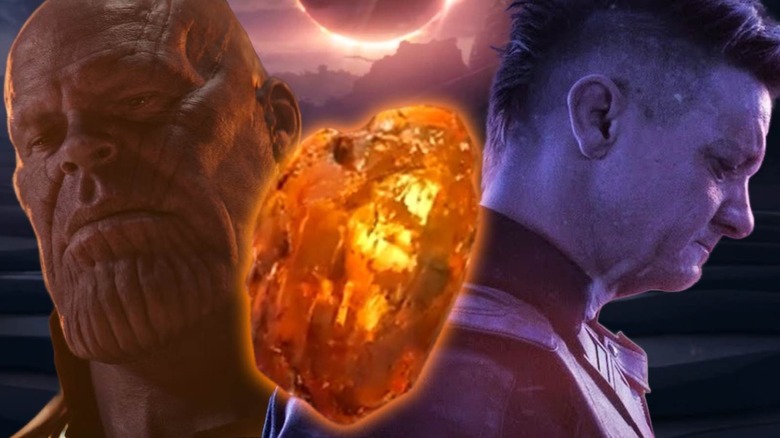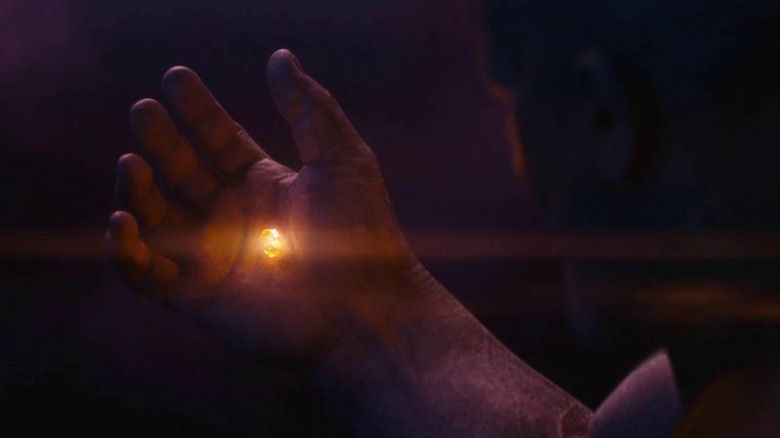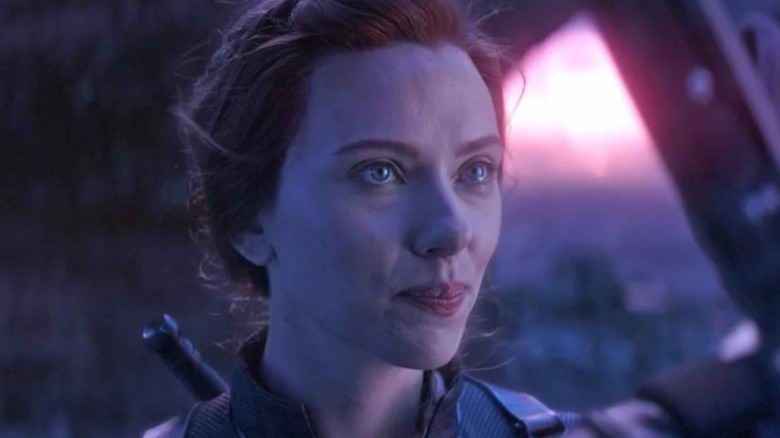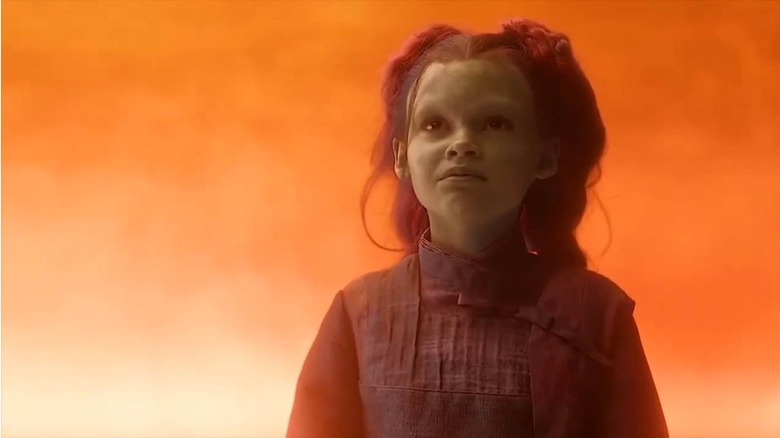Avengers: What Marvel's Soul Stone Does, Explained
They might be considered nothing more than paperweights at the TVA, but the Marvel Cinematic Universe spent 19 films trying to keep tabs on the Infinity Stones, hoping the Mad Titan wouldn't get hold of them. Unfortunately, he did. Half the universe became vacuumable, and one of the film's directors got so traumatized by the experience that he went to a group therapy session with the then-Captain America, Steve Rogers (Chris Evans), following the event. Each posing great danger in their own right, those highly sought-after space nuggets all came with their own exceptional capabilities to wreak havoc on the universe, but none of them were as crucial, powerful, or damaging to the wielder as the Soul Stone.
As one of the earliest events in the MCU, the Soul Stone was like the rest, a byproduct of the Big Bang, and one of the final pieces to Thanos' universe-halving puzzle, as it was for the Avengers during their Time Heist. Stowed away in the far reaches of space, getting hold of the stone is no mean feat and is one of the only ones that anyone not willing to be forever traumatized by the retrieval should skip over entirely. But just what kind of power does the Soul Stone wield, what does it take to get hold of it, and were there any alternative routes that were considered in how to bring it into the MCU? Well, here's where we break it all down and make you ask if it's worth getting hold of, because honestly, we're thinking no.
The Soul Stone is the most dangerous Infinity Stone
Every Infinity Stone should have a warning sign, but the Soul Stone's should be bigger than the rest. Sure, the likes of the Reality Stone can rip open dimensions, and the Time Stone can lead to the past and present collapsing on itself, but the Soul Stone is perhaps the most dangerous because, up until Thanos retrieved it, it was the one shrouded in mystery. Even the oldest Avenger, Thor himself, confessed that Asgardian history had no record of the Soul Stone's capability or its whereabouts, which was eventually revealed in both "Avengers: Infinity War" and "Avengers: Endgame." The scariest trait that puts it apart from the rest of the Infinity Stones, however, is that the Soul Stone has one of the most terrifying advancements that the others do not possess: a grim form of sentience.
While the rest of the stones were mere trinkets that Thanos was after, the Soul Stone operates like it comes with a soul of its own. Unlike the other stones that could be obtained and used by whoever was brave enough to take hold of one, the Soul Stone came at a price for the daring treasure seeker who was after it. Whether a planet-wrecking Titan or a mere mortal with red in their ledger, the Soul Stone would collect its payment in full and could not be undone. Most importantly, it also provided a clear demonstration of just what kind of person could live with the decision they'd made and have to live with thereafter.
The Soul Stone can only be obtained through sacrifice
As revealed in "Avengers: Infinity War" during Thanos' visit to Vormir and the retrieval of the stone, the wielder of the Infinity Gauntlet realized the task at hand was a more formidable challenge to complete than getting the rest for his fancy glove. Only by killing someone they loved in the presence of the stone would it welcome the one brave enough to perform such an act. There'd also be an audience of this dark deed, though, as we learned that the Gatekeeper who stood watch by the stone was none other than the Red Skull, who confessed to being transported to the monument after coming into contact with the Tesseract in "Captain America: The First Avenger."
Cursed to hold witness to all those who visited Vormir, the Red Skull's duty was "guiding others to a treasure I cannot possess," the reason being that he had no love in his heart or for anyone else, unlike Thanos, who sacrificed his own daughter, Gamora (Zoe Saldaña) to recover it. Five years later (or an alternate 2014) and Clint Barton (Jeremy Renner) would be forced to return to the Avengers compound with the stone after Natasha (Scarlett Johansson) decided for the two of them that she'd take the fall to ensure that the stone could be used in bringing back the lost half of the universe. But with such a decision also comes the stone's ability to manipulate its wielder and remind them of just what kind of choice has been made.
The Soul Stone can manipulate the living and the dead
While the death required to obtain the Soul Stone is irreversible, its other capabilities have the power to hold some sway over both the living and the dead. As shown in "Infinity War," once Thanos got his hands on the stone, he could seek out a person's soul. During his battle with Doctor Strange (Benedict Cumberbatch), he put the Soul Stone to use alongside the Power Stone to seek out the then Sorcerer Supreme. Unlike the rest of the super-powered pebbles, the Soul Stone's complete power set was never really utilized, nor was it fully understood by Thanos or the Avengers when they acquired it. Part of a greater set but the most valuable of all, the Soul Stone was able to identify and look into souls, raising the question of whether the person in possession of it had control of the stone or the other way around.
In addition to being able to track down souls and snuff them out of existence with the help of the other stones, the Soul Stone also gave the ability to transport its user to speak with those they'd lost. As if the ultimate sacrifice wasn't enough, the Soul Stone would go on to torture its retriever (in this case, Thanos) by bringing them face-to-face with the life they chose to give away. The grave encounter also provided further display of the power of the stone by doing something that the others couldn't and creating its very own pocket universe known as the Soulworld.
The Soul Stone comes with its own pocket dimension
When the universe was cut down the middle following Thanos' accomplishment, the souls of those who were taken didn't disappear from existence, but were instead stowed away in the Soulworld, a realm and extra perk that came with the Soul Stone. Comprised of only water and a rose-red-tinted never-ending aether, we got a good glimpse of the Soulworld after Thanos killed his daughter. After accomplishing his mission and snapping out half of the universe, the Mad Titan with the soul of Gamora from the first time he met her. As a lone child, the former Guardian of the Galaxy asked Thanos how much his choice cost him, to which he replied, "everything." Shortly after his mission, Thanos revealed to the remaining Avengers that he destroyed the stones with their own powers, and as a result, the Soulworld along with it.
Unfortunately, even during the Time Heist when Clint was forced to see Natasha sacrifice herself to get the Soul Stone back to her friends, the Avenging archer wasn't lucky enough (depending on your point of view) to see her for one last time. Instead, the Black Widow was truly lost, and Thanos was the only one lucky enough to be treated to such a visit, but there were originally many more planned trips into the Soul Stone's pocket world as well as a strong connection to one of the Avengers, in particular.
Steve Rogers was originally considered to be the living incarnation of the Soul Stone
During the many, but not infinite drafts of "Avengers: Endgame" it was revealed in the battle plans for winning back the universe, the Russos had considered putting an interesting spin on the Soul Stone, adding even more importance to this key trinket by connecting it to one of the MCU's most heroic characters. During the ComicBook watch-a-long of "Avengers: Endgame," the directors revealed that they had briefly skirted around the idea of making Steve Rogers (Chris Evans) the human embodiment of the Soul Stone. The brothers wrote in a tweet that "Early on in development talks we considered making Cap the soul stone ... But that idea fell away rather quickly." It seemed like a sensible decision to make, given the undoubtedly dense exposition that would need to be provided to explain how Captain America was somehow linked to something that was created during the Big Bang.
The stone's pocket universe was also considered to play a much larger part in "Avengers: Endgame" than what we ended up with. After Tony Stark (Robert Downey Jr.) had made his heroic last snap against Thanos, a scene was shot and removed from the final cut, which saw him in the Soulworld speaking to a teenage version of his daughter, Morgan (played in the scene by Katherine Langford). While a heartfelt moment between father and daughter, the sequence ended up being cut as test audiences were left confused over what they were actually seeing, proving that the complex power of the Soul Stone is uncontrollable even in the final edit.





